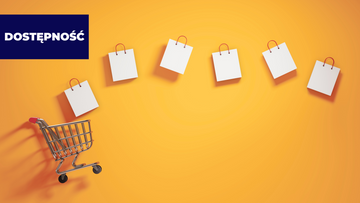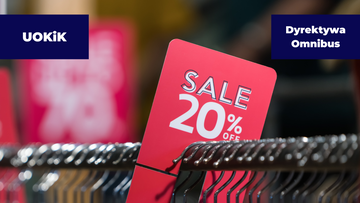Digital Shelf Optimization Strategies for Omni-Commerce Leaders
by Marcin Tomczak on Aug 21, 2024
According to the report "Omni-commerce. I Buy Conveniently 2024," "100% of internet users have made an e-commerce purchase at least once. 87% declare that they have made a purchase online in the last 6 months." This potential of e-commerce challenges brands to stand out with their offerings, provide a competitive product, and meet the expectations of customers who have many different touchpoints at their disposal and are eager to use them. The study also shows that "47% of consumers buy the same brands across different shopping channels. Women (57% vs. 39% of men) and mature individuals aged 34-54 (65%) are more likely to migrate between channels." How can we effectively manage omni-commerce in the face of these trends to improve the customer experience at each level? Digital shelf management may be the answer. What is the digital shelf and how can we effectively leverage its capabilities to build a leading position in the e-shopping ecosystem? Learn effective strategies in this area.
First of all – get to know the digital shelf
The digital shelf is a virtual space where products are presented to consumers in online stores, marketplaces, mobile apps, and search engine results. It also includes reviews, product descriptions, photos, videos, and even advertisements. Digital shelf optimization is a modern product management method that includes monitoring and ongoing improvement of all these elements to ensure a consistent, attractive, and compelling shopping experience. By analyzing online product presentation, digital shelf optimization helps increase sales and product visibility at various levels of presentation. It's also a response to the changing landscape of e-commerce and omni-commerce, where achieving and maintaining a leadership position requires more than just attractive products and competitive prices, and loyalty is "almost nonexistent." As the report "Customer Experience Trends: Revolution or Evolution of Customer Experience," published by Brandly360, shows, "only 3% to 23% of consumers shop in one trusted place—depending on the segment and product type." This compels retailers to seek ways to validate consumer sentiment and win their favor.
The concept of the "digital shelf" is still little known in Poland – 56% of e-managers surveyed in the aforementioned CX study declare their familiarity with and definition of an online store shelf encompassing a product's entire online presence. The same study shows that 28% of e-commerce decision-makers acknowledged that "a brand's tracking of trends and comprehensive management of its presence in digital channels and beyond (omnichannel) in the form of a 'digital shelf' contributes to success in building a positive customer experience." Can these respondents be considered visionaries and leaders? Given that the pace of change is like riding a rollercoaster, the holistic approach offered by digital shelf management can quickly be appreciated by brands.
Secondly, take a few steps to optimize your digital shelf
Following the aforementioned study, the management confirms that "proper management of product descriptions and strategic placement of products in prominent places are the key to success in e-commerce." These are also valuable factors on the way to optimizing the digital shelf, which includes, among others:
1. Providing comprehensive and accurate product information. Customers are looking for detailed descriptions, high-quality photos, videos showing products in use, and reliable reviews. The more valuable content we provide, the greater the chance that consumers will decide to purchase from us.
2. SEO content optimization, which supports product discovery and valuable exposure. These activities include using appropriate keywords in titles, product descriptions, tags, and meta descriptions. It's also important to address technical SEO aspects, such as fast page load times and mobile responsiveness.
3. Data monitoring, which includes metrics such as sales performance, website traffic, and engagement rates, allows for ongoing adjustments to the digital shelf strategy. Analytical tools that diagnose the digital shelf provide information on the level of price volatility of the assortment, promotional campaigns, product availability, advertising banners used in promotional campaigns, sentiment of added reviews, shared content, and information on product features. By also verifying product exposure in search and category lists, digital shelf monitoring tools show brands which products are most popular, how the competition is performing, and how to validate marketing.
Suffice it to say that in this respect, the role of competitive monitoring is evolving toward investing in qualitative information that allows brands to identify rivals' strengths and weaknesses, but also effectively adapt best practices to their own strategies. In this regard, the data will also be invaluable, allowing for the appropriate design of effective pricing strategies, category-specific promotions, and product launches.
Thirdly – be open to trends, i.e. technology in the service of optimizing the digital shelf optimization process
All the elements mentioned above contribute to digital shelf optimization. This area also includes a focus on personalizing the offer, where the use of data on user preferences and behavior allows for the creation of more relevant product recommendations, dedicated offers, and targeted marketing campaigns. Customer reviews and opinions, mentioned above, can be a source of this type of information, playing a key role in building brand trust. Suffice it to say that digital shelf optimization, brand monitoring, and analyzing competitor activities are also supported by modern technologies. Therefore, tools for data aggregation, processing, and analysis incorporate artificial intelligence (AI) and machine learning. This allows for reduced time spent manually tracking trends, redirecting resources to other strategic brand activities. Technology in digital shelf monitoring will also facilitate the personalization of messages, supporting the forecasting of sales trends and, consequently, the creation of appropriate strategies that meet customer needs.
Fourth – prepare for challenges
Digital shelf optimization addresses the needs of modern omnichannel commerce, ensuring increased brand visibility and better positioning in search engine results and on marketplace platforms. Attractive and personalized product presentations attract customers' attention, encouraging purchases and promoting higher conversions. It's also a key element in building customer loyalty – consistent and positive brand experiences mean they'll choose your brand's digital shelf even when migrating between channels. And that's what every provider cares about.
Digital shelf analysis tools simplify the process, freeing up time spent on manual data collection and verification. These systems aggregate data and provide high-quality information on price volatility, promotions, product availability, marketing practices, and content. By analyzing these values through the lens of competitive activity, they foster a stable market position.
It's worth noting that investments in digital shelf optimization must take into account the dynamically evolving omnichannel ecosystem, which requires the rapid adoption of new technologies and a balanced approach to creating unique product selling points (USPs). As technology advances, new challenges emerge, such as information overload and the difficulty of assessing its quality and origin. Stores and retailers must therefore ensure clarity of presentation, avoiding visual overload. However, they can confidently utilize AR and VR technologies, providing an immersive, unique way to display products. Another important aspect of the future of the digital shelf is the development of integration with existing e-commerce infrastructure. Harmonious interoperability with payment, warehousing, and CRM systems will become essential for maintaining operational efficiency.
Sources:
1. Brandly360. (n.d.). Digital shelf: How to maximize product visibility in e-commerce? Retrieved from https://brandly360.com/pl/blog/digital-shelf-jak-tylko-widocznosc-produktow-we-commerce/
2. Brandly360. (n.d.). Webinar: Why digital shelf monitoring will revolutionize your e-commerce? Retrieved from https://brandly360.com/pl/webinar-dlaczego-monitoring-cyfrowej-polki-zrewolucjonizuj-twoj-e-commerce/
3. Brandly360. (n.d.). What is a digital shelf? Retrieved from https://brandly360.com/pl/czym-jest-digital-shelf/
4. Chamber of Digital Economy. (2024). Omni-commerce. I buy conveniently 2024 - summary. Retrieved from https://eizba.pl/wp-content/uploads/2024/07/Omni-commerce-Kupuje-wygodne-2024-skrot.pdf
The author
Beata Ryba, PR & Marketing Manager at Brandly360, manages the marketing and PR aspects of the project, overseeing every detail from strategy to execution. In her daily work, she draws on her experience in B2B marketing, public relations, relationship building, and product management. She is the author of marketing publications, coordinator of projects increasing brand awareness, and co-creator of silver marketing video projects.

About Brandly360
Brandly360 is a unique, comprehensive digital shelf management solution dedicated to manufacturers and online stores. The product provides solutions that analyze various aspects of the digital shelf, including: monitoring product prices and availability, the quality of product-related content in e-commerce, and assessing sentiment and individual product reviews. The solution also verifies the promotional activities of the brand and its competitors in online stores, enabling the most effective digital shelf positioning. Brandly360's goal is to continuously provide customers with the highest quality data to help them make the right business decisions.





